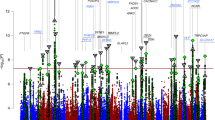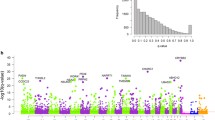Abstract
Multiple genome-wide expression studies of bipolar disorder have been published. However, a unified picture of the genomic basis for the disease has not yet emerged. Genes identified in one study often fail to be identified in other studies, prompting the question of whether microarray studies in the brain are inherently unreliable. To answer this question, we performed a meta-analysis of 12 microarray studies of bipolar disorder. These studies included >500 individual array samples, on a range of microarray platforms and brain regions. Although we confirmed that individual studies showed some differences in results, clear and striking regulation patterns emerged across the studies. These patterns were found at the individual gene level, at the functional level, and at the broader pathway level. The patterns were generally found to be reproducible across platform and region, and were highly statistically significant. We show that the seeming discordance between the studies was primarily a result of the following factors, which are also typical for other brain array studies: (1) Sample sizes were, in retrospect, too small; (2) criteria were at once too restrictive (generally focusing on fold changes >1.5) and too broad (generally using p<0.05 or p<0.01 as criteria for significance); and (3) statistical adjustments were not consistently applied for confounders. In addition to these general conclusions, we also summarize the primary biological findings of the meta-analysis, focusing on areas that confirm previous research and also on novel findings.
Similar content being viewed by others
References
Aguirre Samudio A. J. and Nicolini H. (2005) DRD4 polymorphism and the association with mental disorders. Rev. Invest. Clin. 57, 65–75.
Altar C. A., Jurata L. W., Charles V., Lemire A., Liu P., Bukhman Y., et al. (2005) Deficient hippocampal neuron expression of proteasome, ubiquitin, and mitochondrial genes in multiple schizophrenia cohorts. Biol. Psychiatry 58, 85–96.
Baron M. (2002) Manic-depression genes and the new millennium: poised for discovery. Mol. Psychiatry 7, 342–358.
Barrett T. B., Hauger R. L., Kennedy J. L., Sadovnick A. D., Remick R. A., Keck P. E., et al. (2003) Evidence that a single nucleotide polymorphism in the promoter of the G protein receptor kinase 3 gene is associated with bipolar disorder. Mol. Psychiatry 8, 546–557.
Benes F. M., Matzilevich D., Burke R. E., and Walsh J. (2006) The expression of proapoptosis genes is increased in bipolar disorder, but not in schizophrenia. Mol. Psychiatry 11(3), 241–251.
Bezchlibnyk Y. B., Wang J. F., McQueen G. M., and Young L. T. (2001) Gene expression differences in bipolar disorder revealed by cDNA array analysis of postmortem frontal cortex. J. Neurochem. 79, 826–834.
Blair I. P., Adams L. J., Badenhop R. F., Moses M. J., Scimone A., Morris J. A., et al. (2002) A transcript map encompassing a susceptibility locus for bipolar affective disorder on chromosome 4q35. Mol. Psychiatry 7, 867–873.
Costa E., Davis J., Grayson D. R., Guidotti A., Pappas G. D., and Pesold C. (2001) Dendritic spine hypoplasticity and downregulation of reelin and GABAergic tone in schizophrenia vulnerability. Neurobiol. Dis. 8, 723–742.
De Luca V., Likhodi O., Van Tol H. H., Kennedy J. L., and Wong A. H. (2005) Tryptophan hydroxylase 2 gene expression and promoter polymorphisms in bipolar disorder and schizophrenia. Psychopharmacology (Berl.) 183, 378–382.
Dennis G. Jr., Sherman B. T., Hosack D. A., Yang J., Gao W., Lane H. C., and Lempicki R. A. (2003) DAVID: Database for Annotation, Visualization, and Integrated Discovery. Genome Biol. 4, P3.
Eastwood S. L. and Harrison P. J. (2000) Hippocampal synaptic pathology in schizophrenia, bipolar disorder and major depression: a study of complexin mRNAs. Mol. Psychiatry 5, 425–432.
Fatemi S. H., Laurence J. A., Araghi Niknam M., Stary J. M., Schulz S. C., Lee S., and Gottesman I. I. (2004) Glial fibrillary acidic protein is reduced in cerebellum of subjects with major depression, but not schizophrenia. Schizophr. Res. 69, 317–323.
Grayson D. R., Jia X., Chen Y., Sharma R. P., Mitchell C. P., Guidotti A., and Costa E. (2005) Reelin promoter hypermethylation in schizophrenia. Proc. Natl. Acad. Sci. U. S. A. 102, 9341–9346.
Higgs B. W., Elashoff M., Richman S, and Barci B. (2006) An online database for brain disease research. BMC Genomics 7, 70.
Hurd Y. L. (2002) Subjects with major depression or bipolar disorder show reduction of prodynorphin mRNA expression in discrete nuclei of the amygdaloid complex. Mol. Psychiatry 7, 75–81.
Iwamoto K., Bundo M., and Kato T. (2005) Altered expression of mitochondria-related genes in postmortem brains of patients with bipolar disorder or schizophrenia, as revealed by large-scale DNA microarray analysis. Hum. Mol. Genet. 14, 241–253.
Iwamoto K., Kakiuchi C., Bundo M., Ikeda K., and Kato T. (2004) Molecular characterization of bipolar disorder by comparing gene expression profiles of postmortem brains of major mental disorders. Mol. Psychiatry 9, 406–416.
Jurata L. W., Bukhman Y. V., Charles V., Capriglione F., Bullard J., Lemire A. L., et al. (2004) Comparison of microarray-based mRNA profiling technologies for identification of psychiatric disease and drug signatures. J. Neurosci. Methods 138, 173–188.
Kakiuchi C., Iwamoto K., Ishiwata M., Bundo M., Kasahara T., Kusumi I., et al. (2003) Impaired feedback regulation of XBP1 as a genetic risk factor for bipolar disorder. Nat. Genet. 35, 171–175.
Kan P. X., Popendikyte V., Kaminsky Z. A., Yolken R. H., and Petronis A. (2004) Epigenetic studies of genomic retroelements in major psychosis. Schizophr. Res. 67, 95–106.
Kapczinski F., Frey B. N., and Zannatto V. (2004) Physiopathology of bipolar disorders: what has changed in the last 10 years? Rev. Bras. Psiquiatr. 26, 17–21.
Kato T., Kuratomi G., and Kato N. (2005) Genetics of bipolar disorder. Drugs Today (Barc.) 41, 335–344.
Kelsoe J. R. and Niculescu A. B. III (2002) Finding genes for bipolar disorder in the functional genomics era: from convergent functional genomics to phenomics and back. CNS Spectr. 7, 215–216, 223–216.
Kim E. H., Kim T. S., Sun W., Kim D. S., Chung H. S., Kim D. K., and Park S. H. (2004) Differential regulation of metallothionein-I and metallothionein-II mRNA expression in the rat brain following traumatic brain injury. Mol. Cells 18, 326–331.
Koh P. O., Undie A. S., Kabbani N., Levenson R., Goldman-Rakic P. S., and Lidow M. S. (2003) Up-regulation of neuronal calcium sensor 1 (NCS-1) in the prefrontal cortex of schizophrenic and bipolar patients. Proc. Natl. Acad. Sci. U. S. A. 100, 313–317.
Konradi C. (2005) Gene expression microarray studies in polygenic psychiatric disorders: applications and data analysis. Brain Res. Brain Res. Rev. 50, 142–155.
Konradi C., Eaton M., MacDonald M. L., Walsh J., Benes F. M., and Heckers S. (2004) Molecular evidence for mitochondrial dysfunction in bipolar disorder. Arch. Gen. Psychiatry 61, 300–308.
Kuromitsu J., Yokoi A., Kawai T., Nagasu T., Aizawa T., Haga S., and Ikeda K. (2001) Reduced neuropeptide Y mRNA levels in the frontal cortex of people with schizophrenia and bipolar disorder. Brain Res. Gene Expr. Patterns 1, 17–21.
Law A. J. and Deakin J. F. (2001) Asymmetrical reductions of hippocampal NMDAR1 glutamate receptor mRNA in the psychoses. Neuroreport 12, 2971–2974.
Law A. J., Weickert C. S., Hyde T. M., Kleinman J. E., and Harrison P. J. (2004) Reduced spinophilin but not microtubule-associated protein 2 expression in the hippocampal formation in schizophrenia and mood disorders: molecular evidence for a pathology of dendritic spines. Am. J. Psychiatry 161, 1848–1855.
Lenox R. H. and Hahn C. G. (2000) Overview of the mechanism of action of lithium in the brain: fifty-year update. J. Clin. Psychiatry 61, 5–15.
Maier W., Hofgen B., Zobel A., and Rietschel M. (2005) Genetic models of schizophrenia and bipolar disorder: overlapping inheritance or discrete genotypes? Eur. Arch. Psychiatry Clin. Neurosci. 255, 159–166.
Manji H. K., Bebchuk J. M., Moore G. J., Glitz D., Hasanat K. A., and Chen G. (1999) Modulation of CNS signal transduction pathways and gene expression by mood-stabilizing agents: therapeutic implications. J. Clin. Psychiatry 60, 27–39, 40–21, 113–116.
Molnar M., Potkin S. G., Bunney W. E., and Jones E. G. (2003) MRNA expression patterns and distribution of white matter neurons in dorsolateral prefrontal cortex of depressed patients differ from those in schizophrenia patients. Biol. Psychiatry 53, 39–47.
Munakata K., Iwamoto K., Bundo M., and Kato T. (2005) Mitochondrial DNA 3243A>G mutation and increased expression of LARS2 gene in the brains of patients with bipolar disorder and schizophrenia. Biol. Psychiatry 57, 525–532.
Natale J. E., Knight J. B., Cheng Y., Rome J. E., and Gallo V. (2004) Metallothionein I and II mitigate age-dependent secondary brain injury. J. Neurosci. Res. 78, 303–314.
Ogden C. A., Rich M. E., Schork N. J., Paulus M. P., Geyer M. A., Lohr J. B., et al. (2004) Candidate genes, pathways and mechanisms for bipolar (manic-depressive) and related disorders: an expanded convergent functional genomics approach. Mol. Psychiatry 9, 1007–1029.
Raybould R., Green E. K., MacGregor S., Gordon-Smith K., Heron J., Hyde S., et al. (2005) Bipolar disorder and polymorphisms in the dysbinding gene (DTNBP1). Biol. Psychiatry 57, 696–701.
Sun Y., Zhang L., Johnston N. L., Torrey E. F., and Yolken R. H. (2001) Serial analysis of gene expression in the frontal cortex of patients with bipolar disorder. Br. J. Psychiatry 41, s137-s141.
Thomson P. A., Wray N. R., Millar J. K., Evans K. L., Hellard S. L., Condie A., et al. (2005) Association between the TRAX/DISC locus and both bipolar disorder and schizophrenia in the Scottish population. Mol. Psychiatry 10, 616, 657–668.
Tkachev D., Mimmack M. L., Ryan M. M., Wayland M., Freeman T., Jones P. B., et al. (2003) Oligodendrocyte dysfunction in schizophrenia and bipolar disorder. Lancet 362, 798–805.
Torrey E. F., Webster M., Knable M., Johnston N., and Yolken R. H. (2000) The Stanley Foundation Brain Collection and Neuropathology Consortium. Schizophr. Res. 44, 151–155.
Veldic M., Guidotti A., Maloku E., Davis J. M., and Costa E. (2005) In psychosis, cortical interneurons overexpress DNA-methyltransferase 1. Proc. Natl. Acad. Sci. U.S.A. 102, 2152–2157.
Webster M. J., Knable M. B., O’Grady J., Orthmann J., and Weickert C. S. (2002) Regional specificity of brain glucocorticoid receptor mRNA alterations in subjects with schizophrenia and mood disorders. Mol. Psychiatry 7, 924, 985–994.
Woo T. U., Walsh J. P., and Benes F. M. (2004) Density of glutamic acid decarboxylase 67 messenger RNA-containing neurons that express the N-methyl-D-aspartate receptor subunit NR2A in the anterior cingulate cortex in schizophrenia and bipolar disorder. Arch. Gen. Psychiatry 61, 649–657.
Author information
Authors and Affiliations
Corresponding author
Rights and permissions
About this article
Cite this article
Elashoff, M., Higgs, B.W., Yolken, R.H. et al. Meta-analysis of 12 genomic studies in bipolar disorder. J Mol Neurosci 31, 221–243 (2007). https://doi.org/10.1385/JMN:31:03:221
Received:
Accepted:
Issue Date:
DOI: https://doi.org/10.1385/JMN:31:03:221




